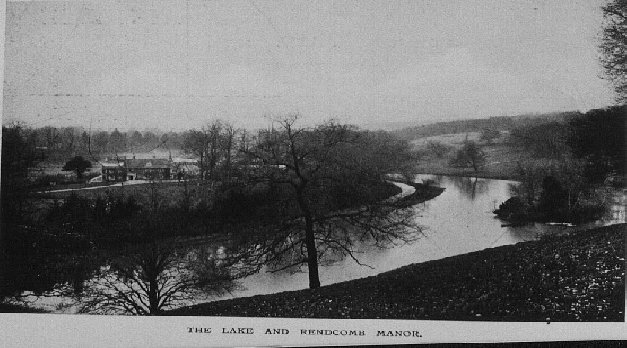Eycot Manor
All the land west of the Churn in Rendcomb made up the ancient manor of Eycot. Today the Rendcomb parish boundary is that of the manor. [ Historia and Cartularium Monasterii Sancti Petri Gloucester. ed. W.H. Hart; Rolls series no. 33 three vols. 1863 - 87 ii 41] Whether the boundary for Eycott is the same as previous to 1732 is not known. There were 8 inhabitants for the 1327 subsidy. [Gloucester Subsidy roll 14]In 1381 there were 12 for the poll tax.[E 179/113/35a r 2a]There were still a few tenants there in 1442. [Gloucester Record Office D678 Sherbourne estate court rolls] No later records have been found.
The merging of Eycot with Rendcomb was not entirely natural. Eycot was in a different hundred and although adjacent it occupied the west bank and hills of the Churn. Rendcomb was up a steep hill overlooking the valley on the east. Over the middle ages few Eycotts were connected with Rendcomb, their natural commerce was with Woodmancote, Bagendon and North Cerney.
The manor house was recorded as Eycot farm to 1732 [GRO D326 ]. The farm buildings at Eycotfield were the only buildings on high ground in 1837.[ Gloucester Diocese Record T1/147]. In 1930 a house was built on the high ground. The manor house was most likely the property now known as Lodge farm or now Rendcomb Manor. Part of that building gates to 1600. Farm buildings were located on higher ground where Aycote house now stands. The village had a few families but the hamlet was pretty well gone by the 1500's.
In 1086 one hide was held by Ordric (Ordvic) from the bishop of Worcester via Bibury. [Domesday book 164v] an intermediate lordship between the bishop and tenant in demesne was held by Gilbert de Mynors (Miners) and Roger de Mynors at different times in the 1100's. Gilbert de Miners was born at Eycot about 1087 and died after 1127 at Eycot.
At Eycot in 1086 there were 2 Villani ( villein, above a border did the primary estate work for the lord ) and 4 bordars (renting 5 to ten acres for self supporting farming) with 2 teams. All were essentially serfs not free men.
From Roger it passed to Roger Mucegros [Red Book of Worcester 414-15, 439]. In 1209 and later the land was said to be held directly by the bishop and assessed 1/3 knights fee [Book of Fees i.39, Feudal Aids ii 248] Early holders of the manor were Reynold and Richard of Beckford who made a grant of tithes in Eycot to Gloucester Abbey before 1100. [Gloucester Cathedral Library register Abb Froucester B pp 83-4] [ Hist. & Cart. Mon. of Glou. rolls ii 41 cf. reg. Regnum Anglo Norman ii, 104] At some time in 1100's the manor was held by Robert Russell in the name of his wife Basile and his
heir William [Gloucester Cathedral Reg.Abb Froucester B pp 83-84] [Red Book of Worcester 439] This was perhaps William Russel who held Eycot in 1209. His widow, Alice was challenged in ownership by John Russel. Robert Russel got a small estate conveyed to him in 1241. He may have managed to get the manor from her because under law she was entitled to 1/3 of the estate. Her husband had given it all to her.
John Le Brun married Margery, daughter of John Russel and obtained from Walter Wyth ˝ a ploughland in nether (lower) Rendcomb, Woodmancote and North Cerney as well as Eycot. This was in 1303. In 1312 his widow Margery granted Eycot to Thomas Neel of Purton. A contingent remainder in the grant was that the manor was for the benefit of John of Burton (Purton ?) and his heirs. One of whom was Thomas Burton who held the manor in 1346.
In 1375 there were 120 arable acres of land, half of which were out of cultivation and the other half hilly and unprofitable land. The land became sheep grazing ground. The Earl of Stafford employed a shepherd there in the late 1300's with 328 sheep. Murraine kept breaking out and by 1440 the flock was so unprofitable it was given up. The lord of the manor in 1375 got 23 shillings in rent from the tenants indicating the fact that the plague had decimated the population and the villeins and bordars were now simply tenants leasing the land.
Thomas Burton died in 1375 leaving his estate to his son Thomas, a minor. William Archibald was made the boys custodian. A description of the property at the time is available. [ Cal. Inq. P.M. XIV pp 94-95] In 1385 John Atwood claimed the manor was his because of a grant made by John Russel to his ancestors Robert and Margery Crook in the reign of Edward II. John Atwood was awarded seisen ( ownership under rightful title) from Burton. The following year the land was granted to John Pouger who died in 1405. In 1410 his son John settled an ownership dispute with John Warre, nephew and heir of the younger Thomas of Burton. The land returned to the Burton heirs. By 1421 the land was in the possession of the Abbey at Winchcombe. Warre's sister Catherine and another Burton heir, Robert Andrew challenged the Abbey who had to settle with them for ownership.
After the dissolution of abbeys by Henry VIII, in 1536-40, the manor passed into the hands of Edmund Tame whose widow Catherine held
it after his death. It then became included with Rendcomb and was owned by the Staffords. It was likely included in the sale to Richard
Berkeley in 1564. They kept Eycot as a residence until about 1690. The capital messuage (main set of buildings or main dwelling) may
have been what is now known as Lodge Farm or Rendcomb Farm. It was to Rendcomb that Elizabeth 1st came to visit him in September of
1592 as he was then a member of her court. This Richard was not a leading Berkeley when he was born but did own Marsden and at the
time he bought Rendcombe he also bought Calmsden. He was appointed Lieutenant of the Tower of London under Elizabeth and was a privy
council member. Some of his family had catholic leanings but he navigated politics astutely. Berkely built his main residence at Stoke
Gifford. In 1647 Sir Maurice Berkeley of Redcomb had his estates, as did his relative Richard Berkeley had his estates taken from
them as they had raised against parliament and had not paid their fees for 1644 and 45. Parliament granted them a pardon as they had
paid the fees and fines in 1647. This was during the civil war.
800's existence of Eycot known on Saxon charters
1066 Bishop of Worcester held by Alric
1086 Bishop of Worcester held by Ordric
1 hide; 4 hides held by 3 riding men (absentee owners)
Half the demesne tithes of Eycott were granted by Reynold and Richard of Beckford to
Gloucester abbey before 1100. This was later commuted to a pension paid to the Abbey priest serving the chapel at Eycott in the 12th and
13th centuries. By 1291 the rector of Rendcomb was accused of taking the pension so the chapel likely had gone out of service by then.
1100's Bishop of Worcester to Robert de Moynors (Miners)
held by Reynold of Beckford
to Roger de Moynors
held by Richard of Beckford
to Roger Mucegros
held by Robert & Basile(wife) Russel
1209 Bishop of Worcester
held by William & Alice(wife) Russel (son of R'bt)
1241 John Russel.................... (in dispute by) Robert Russel
1303 to daughter Margery
wife of
1312 John Le Brun
1346 Margery grants to Thomas Neel of Purton
for the use of
Thomas Burton
1375 Thomas Burton Jr. age 11, inherits
1385 Robert Atwood cites claim via ancestor Robert Russel
He gets land
He grants land to
1386 John Pougher
1410 John Pougher Jr. inherits
1421 John Warre makes claim via Burtons takes land from Pougher
and gives to Winchcombe Abbey
1534 King Henry VIII dissolves Abbey ownership and essentially seizes the land which he sells.
1540 Edmund Tame of Fairford and wife Catherine (Stafford)
acquire land from the King as a result of the Dissolution.
Eycot becomes a part of Rendcomb Park estate. Ceases to exist as a separate entity.
1547 The Stafford family holds the land
1564 Richard Berkeley of Stoke Gifford acquires.
1635 The Guise family assumes ownership. Maurice Berkeley sells it and Richard leases it back. However the deal did not include all rights. Richard Berkeley is fined for cutting trees down that were not his but Guises. The Berkeleys a decade later are still paying taxes on the land.
1647 Maurice and Richard Berkeley of Rendcomb are pardoned by Parliament for not paying fees in 1644-5. Fees and fines which they paid for their lands. They were supporters of the King and not Parliament. This is some time after the Guises were claiming ownership. It appears that until 1690 or so Berkeleys did remain on the property. Descendants of the Guises control the estate until 1864.
The manor-house, which was absorbed with the rest of the manor into the Rendcomb estate, was recorded by the name Eycot Farm until
1732. The house dates partly from the 17th century but has an early-19th-century wing and some 20th-century additions in Cotswold
style.
Toward the end of the 1700's most of the property was taken out of lease to tenants and used as pasture.
1864 Rendcombe Estate is established and the owners include Sir Francis Goldsmid and others.
1914 An estate of 4,700 acres is broken up into several holdings.
1984 Carron Mann owns a small holding along the Churn R. which may be the site of the original manor. The Lodge dates to about 1600. Eycot or Aycote house(1934) occupies another possible site though to be farm buildings.
No record exists of an Eycot in ownership or in residence on this land at any time in recorded history. None of the records from the 1300's when “de Eycot” exists name such a person. This may be due to the fact that the name was first used by a person from there and not of there.
The Eycots earliest records are next door in Woodmancote, Rendcomb, North Cerney and Bagendon although they may have been villagers, slaves or small holders at Eycot they were never the landlords. Margery Le Brun and her husband have control of Eycot at the time that John of Eycot, one of the first known local Eycots, is a townsman in Cirencester.
Someone, someplace owns the Lordship of the manor of Eycot to this day. However the lordship conveys no status or title.
At an Inquisition Post Mortem taken after the death of Thomas Burton respecting the disposition of his estate the following information is recorded.
" Inquisition Post Mortem taken at Cirencester on Saturday
the Feast of S.S. Tiburcius and Valerian, 1375 thus:- Thomas
de Berton was seised in his demesne as of fee on the day he
died, of the manor of Eycote, held of the King, by reason of
the temporalities of the Bishopric of Worcester being in his
hand, as of the manor of Bibury, by knight service and the
payment of 12d. and six bushels of corn at Martinmas, with
suit of court at the said manor of Bibury twice a year.
There is a capital messuage there with a garden worth nothing
a year, beyond the reprises; 60 acres of arable land, worth
10s and not more because the land is hilly; 60 acres of
arable land worth nothing because they are lying
uncultivated; 5 acres of meadow worth 10s. a year; a parcel
of underwood, worth 12s.; 23s.1d. of the rents of the tenants
at will. The pleas and perquisites of the court are worth
nothing beyond the reprises. The said Thomas also held a
messuage and a half virgate of land in Rodmerton from Henry
Borden by knight service and the payment of 12d. a year,
worth 4s. a year clear. The said Thomas died on Friday after
the Feast of St. Gregory the Pope last past. Thomas his son
and heir was eleven on the feast of the Annunciation last
pas t."
Thomas Burton or Berton had acquired Eycote in 1346 and owned it until his death mentioned above. During this period of time England went through a great depopulation caused by the Black Death which began in 1349 and raged for many years. There were many farms abandoned and this was due to death and the lack of people to purchase the crops. The Manor was clearly not a highly valued property at the time.
The quotation from above says that on the day he died he had possession of his land, the manor of Eycote which the King had entrusted to the Bishop of Worcester who was lord of Bibury and Eycote was owing allegiance to Bibury. So Burton had to give service as a knight to the Bishop or King when required. He also had to pay 12 shillings and six bushels of grain each year at Martinmas ( Nov.11) and had to appear at the court at Bibury twice a year to present information for the Bishop. There was a main farmhouse with a garden that produced only enough for the occupants. There were sixty hill acres. 60 acres which could be ploughed but was not so made no money. The five acre meadow, likely along the river was good grassland. There was a wood lot as well. The tenants paid rent of 23 shillings one pence. The manor court did not make any money other than meeting expenses settling matters among
the tenants. Thomas also was lord of property in Rodmerton. His knight Henry Borden paid 12 a pence a year on land valued at four shillings. His son Thomas Jr. was eleven years old. The son's estate was entrusted to William Archibald. When Thomas was about 20 John Attwood went to court to prove an earlier owner had left the farm in his family. He and his relatives got it back, William Russel among them , and they gave it to the Abbey at Winchcombe which kept it until Henry VIII dissolved the abbeys. Edmund Tame of Fairford got the land in 1540.
C. H. C. Osborne, J. C. James, and K. L. James, Hist. of Rendcomb College (Oxford, 1976), 23—4,29, 121, 152—7.
Victoria County Series, History of Gloucestershire, Vol 7. 1981
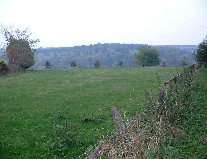
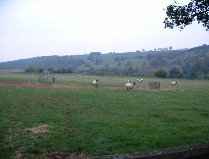
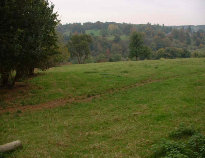
Views of Eycot Manor lands looking north east - October 2005 - click on to enlarge.
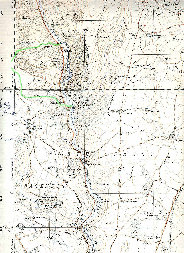
Topographic map showing boundary of Eycot in green. Click to enlarge.
